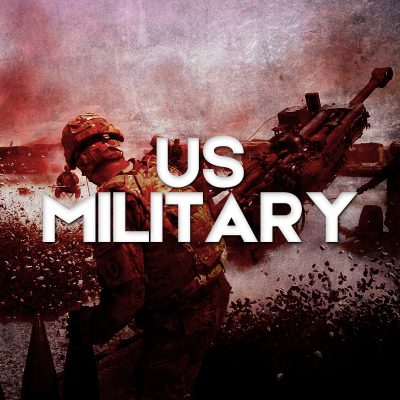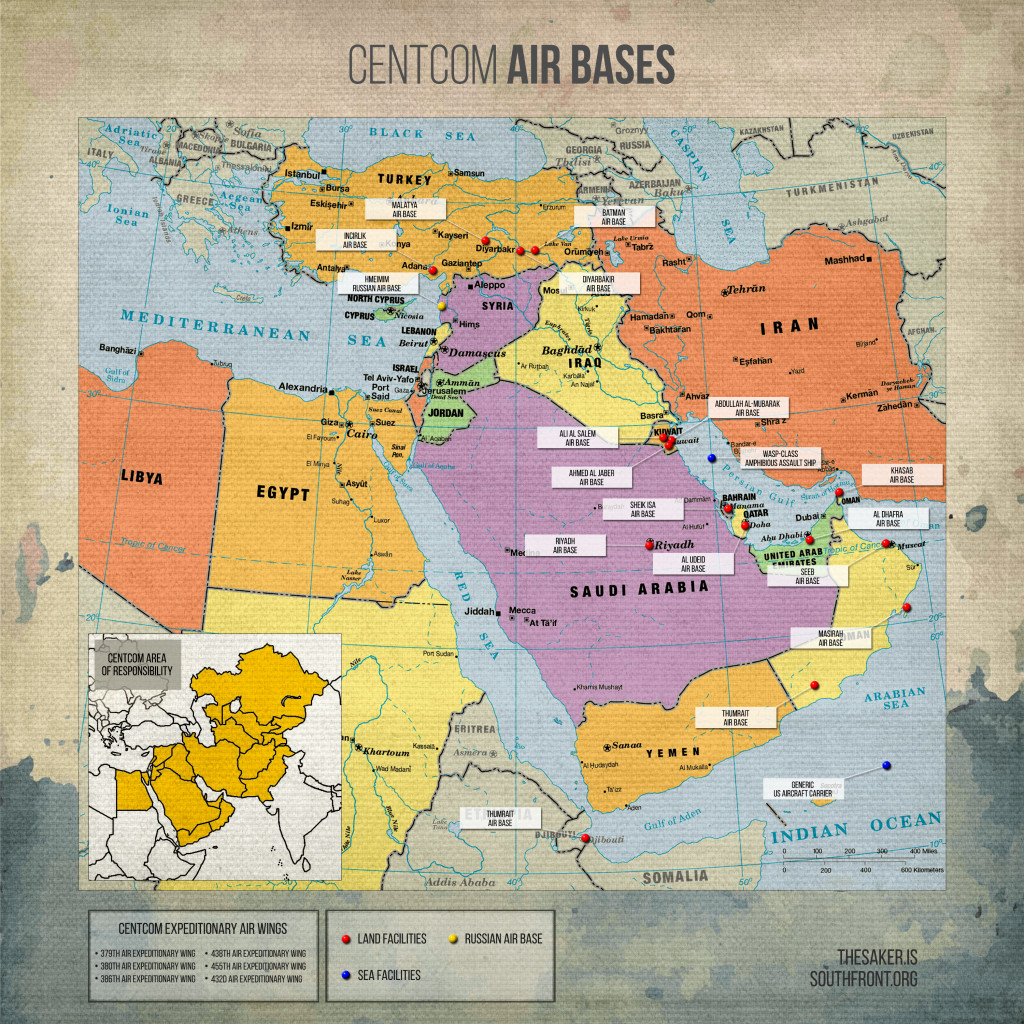This is first from a series of articles dedicated to the assets and capabilities of the US-led ‘anti-ISIS’ coalition in the Middle East

Written by Igor Pejic exclusively for SouthFront: Analysis & Intelligence
In the past four years the US has been more or less involved directly or by proxies, agents and allies in the Syrian conflict. The barrage of accusations for a violation of human rights, dictatorship, killing of innocent civilians was a regular method by which the Western powers justified their involvement in the internal affairs of other countries. However, after four years of bloodshed the so called “soft power” did not yield any results.
President Bashar Al-Assad is still in power, supported by the vast majority of people in the country, as well as abroad. The moderate opposition, if there was any in the first place, is marginalized and has little or no effect in thefight against the terrorists. The Islamic State has spread throughout Iraq and Syria, and now this new entity has become a major threat not only in the Middle East but in the other parts of the globe. Lastly, and maybe the biggest problem for the US and NATO is the Russian military action against the Islamic State, which seems to be so successful that the Western powers need to reassign their military forces in order to maintain their presence in the region. The trouble for the coalition doesn’t end there. The Turkish actions against the Russian Air Force, involvement in an oil-smuggling and their murky policy towards the Islamic State puts NATO in a rather bad position.
In the past few days we are witnessing an intensive effort of the coalition, especially the US, in order to show that they are battling the Islamic State almost as good as Russia. The air raids which have started more than a year ago didn’t show any results, and the most recent ones targeted Syrian forces instead of the forces of the Islamic State. Many have claimed it was a mistake, an accident if you will, but dropping a bomb from that height and directly hitting a military camp killing three Syrian soldiers is not something that happens by chance. This act of aggression can be interpreted as a demonstration of power, something similar to what Turkey did when they shot the SU-24, showing that the US along with its allies is still present in the region and won’t be pushed around by anyone including those who are trying to fight terrorism. Although many Western countries declared war against Daesh, usually all we can hear, are the efforts of the US, lately France and Germany as well. So, who does constitute this coalition against the Islamic State? The coalition includes more than forty countries around the world that have in some way contributed to the fight against Daesh, from sending humanitarian aid and ammunition to those who fight Daesh like Bulgaria and Hungary, to the air strikes like the US and France. On the other hand, the coalition also includes countries like Turkey, Saudi Arabia, Qatar and Bahrain with a rather suspicious intention towards this conflict. These “suspicious” countries are also very important to the US and their military force in the Middle East since every one of those countries has US military presence on their soil.
The US military activity in the Middle East
- Incirlik Air Base, the most used base in Turkey, last year allowed the US unmanned aircrafts (drones) to be deployed in order to strike targets in the ISIS controlled areas. There are also discussions for manned aircrafts as well. This could be expected especially since the downing of the SU-24. Beside Incirlik base the US military is stationed at Diyarbakir (civilian airport also a military air base), Batman (local airport also a military base) and Malatya (airport also air base).
- Last year the US military participated in Jordan’s military exercise called “Eager Lion” with more than 6,000 troops. After this military exercise Jordan became the home ofthe Central Command forward-deployment of 1,500 American troops who assist the Jordanians security forces.President Obama allowed the deployment of additional special force units to Jordan in order to assist in the training missions.
- The US Navy deployed two ships in January last year in the Red Sea, USS Iwo Jima and USS Fort McHenry, as a precaution measure if the situation in Yemen further deteriorates. Alongside these battleships there is also the Amphibious Ready Group/Marine Expeditionary Unit team.
- In Saudi Arabia the US has around 300 troops supporting training missions. The US Central Command works alongside the Saudi armed forces promoting education and joint military exercises. Tabuk Air Base in Saudi Arabia is also a very important asset for the US and its allies since the proximity to Jordan and Iraq. Riyadh Air Base is also one for the most important oversees US base due to its strategic location. Eskan village hosts American 64thAir Expeditionary Group around 300 troops. Taif Air Base operated by Saudi’s military is used by the US for logistic support. Jedah Air Base operated by the Royal Saudi Air Force also provides logistic support for US troops as well as military training missions.
- In the UAE, Al Dhafra Air Base is used to maintain the US aircrafts which are used to bomb the ISIS targets in Iraq and Syria. Although the exact number of aircrafts is confidential, there are reports which suggest that at least five F-22 fighter jets have been deployed to this air base. Fujairah Naval Base is on the crucial geostrategic point, opened in 2010 this base allows direct access to the Arabian Sea.
- Al Udeid Air Base near Doha is a crucial point in the Operation Inherent Resolve against ISIS. This base houses around 8,000 US military personnel with dozens of jets. The aircrafts seen in al Udeid are B-1 bombers, F-15E Strike Eagles, F-16 Fighting Falcons. The Pentagonhas alsostated that C-17s Globemaster and C-130s Herculeshave been used to distribute the airdrops of humanitarian aid in the northern Iraq.
- The US Navy’s 5th fleet headquartered in Bahrain which conducts constant patrols, exercises and combat operations has been boosted with the Nimitz-class aircraft carrier George H.W. Bush. The carrier has been moved from the Arabian Sea to the Northern Arabian Gulf. Muharraq Air Base is also used by the US Navy and US Marines, usually ships supplies. Bahrain’s Sheik Isa Air Base has a camp established by the US in 2009 in order to support aerial missions in the region. The base was also used by the US during the first Gulf war.
- Kuwait is one of the most important military grounds for the US in the Middle East. More than 23,000 US military personnel are stationed in this country, this includes the 1stinfantry Division’s and 1stBrigade Combat Team. Kuwait’s Ali al Salem Air Base hosts the 386th Air Expeditionary Unit, which provides airlift for the US Central Command throughout the Persian Gulf. Kuwait also hosts Camp Patriot which was established during the invasion of Iraq. Camp Patriot supports the one and only Amphibious Seabees group, part of the US Navy. Ahmed al
- Jaber Air Base is operated by Kuwait and US Air Force.
- Masirah Base in Oman was established in the 1930 by the British, today its used by Oman’s military but it’s also used as a military depot for the US.
Despite this vast military presence of the US in the Middle East, and the constant reports of sorties and air strikes on the Islamic State, there haven’t been any devastating effects on the jihadists and their progression in Syria and Iraq. All of this brings up a question: what does the US and their allies really want to accomplish in the Middle East? As I previously stated in my articles on the Middle East crisis, the threat of the Islamic State and terrorism which spreads through Syria and Iraq isn’t a military question but a political one. If the regime in Syria fails and the country descends into a total chaos, all those jihadists would easily find their way across Turkey to theCaucasus region. This scenario would be a major problem for Russia and also allow other powers, by the proxies or “moderate rebels”, to make a foothold for further operations on Russian soil. This scenario wouldn’t only threaten Russia but Iran as well. If this extremism spreads across Syria and Iraq, Iran would lose its connections to Lebanon and Shia Muslims further west, also the country would find itself surrounded by various jihadists groups from Iraq in the west and Afghanistan in the east.Keep in mind, these groups could find great support in therich Gulf countries. A destabilization of Iran and the Caucasus region would make a great entry point for the famous geostrategic pivot area which includesRussia and Central Asia.






Centacom air bases could be terminated with less that 40 Kalibr missiles . Military bases in the year 2015 are a burden if they cannot defend against supersonic missiles .
Is the author a retard?
A “military analysis” that does not understand the logic of the Enemy is not an analysis.
What you’ve done here is a mapping of enemy infrastructure.
If that is what They do, that is what They are, that is what They want.
Read and apply Sun Tzu, Chapter III Waging War, points 6 & 7.
Hey Mouse. Maybe you can write the better article. Surprise us! ;)
Whoa easy big fella….NOT EVERYONE can be a “Sun Tzu”-esque analyst of their enemies’ motives, tactics, techniques, etc..